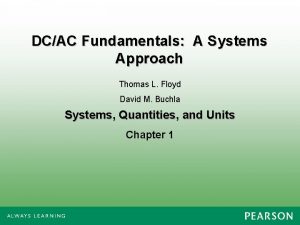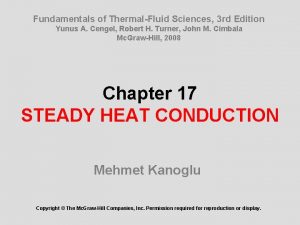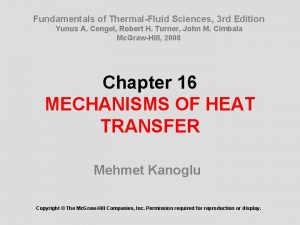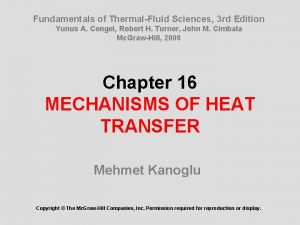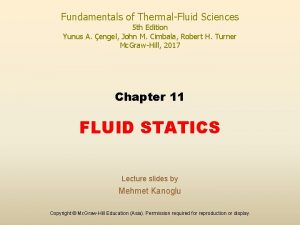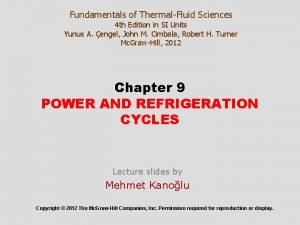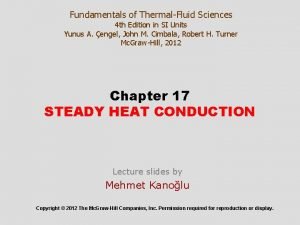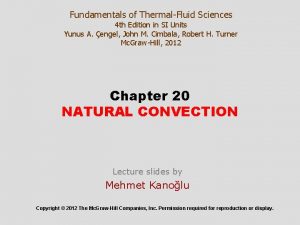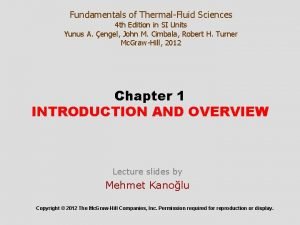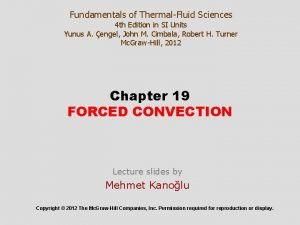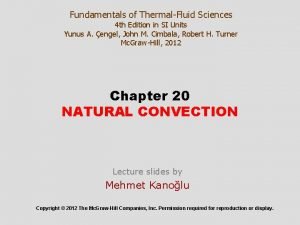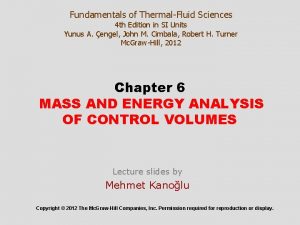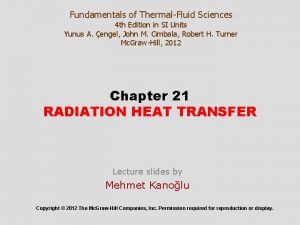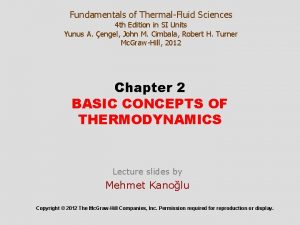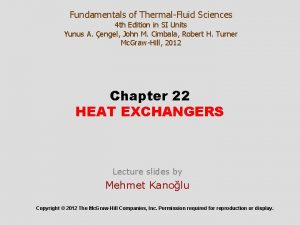Fundamentals of ThermalFluid Sciences 3 rd Edition Yunus


















- Slides: 18

Fundamentals of Thermal-Fluid Sciences, 3 rd Edition Yunus A. Cengel, Robert H. Turner, John M. Cimbala Mc. Graw-Hill, 2008 Chapter 19 FORCED CONVECTION Mehmet Kanoglu Copyright © The Mc. Graw-Hill Companies, Inc. Permission required for reproduction or display.

Objectives • Understand the physical mechanism of convection and its classification • Visualize the development of thermal boundary layer during flow over surfaces • Gain a working knowledge of the dimensionless Prandtl and Nusselt numbers • Develop an understanding of the mechanism of heat transfer in turbulent flow 2

PHYSICAL MECHANISM OF CONVECTION Conduction and convection both require the presence of a material medium but convection requires fluid motion. Convection involves fluid motion as well as heat conduction. Convection heat transfer cofficient is a strong function of velocity. 3

Convection heat transfer strongly depends on the fluid properties: • • dynamic viscosity, thermal conductivity, density, specific heat, fluid velocity, geometry , the roughness of the solid surface, the type of fluid flow (such as being streamlined or turbulent). Newton’s law of cooling Convection heat transfer coefficient, h: The rate of heat transfer between a solid surface and a fluid per unit surface area per unit temperature difference. 4

How to determine heat transfer coefficient in each cases involving force convection? Due to no slip condition, heat transfer between plate and adjacent fluid layers (stick to plate, no fluid motion) is conduction heat transfer. As we move far from solid surface, heat is convected due to fluid in motion. Equate two of the above equations, we obtain, It shows that we need to find the temperature gradient at the wall in order to evaluate the heat transfer coefficient, h. h varies along flow direction and thus, the average value of h was used. 5

How to determine heat transfer coefficient in each cases involving force convection? Due to no slip condition, heat transfer between plate and adjacent fluid layers (stick to plate, no fluid motion) is conduction heat transfer. As we move far from solid surface, heat is convected due to fluid in motion. Equate two of the above equations, we obtain, It shows that we need to find the temperature gradient at the wall in order to evaluate the heat transfer coefficient, h. h varies along flow direction and thus, the average value of h was used. 6

A non dimensional heat transfer coefficient, Nusselt Number, was introduced. This number represent the ratio of conductive heat transfer to convective heat transfer. It tell us about the enhancement of heat transfer through fluid layer as a result of convection relative to conduction across the same fluid layer. Before we proceed further, let us see another parameter for convection heat transfer i. e. Prandtl Number. 7

Boundary Layers Velocity Boundary Layer Thermal Boundary Layer Prandlt Number relate the velocity boundary layer and thermal boundary layer. 8

HOW DOES NUSSELT, PRANDTL HELP IN DETERMINING HEAT TRANSFER COEFFICIENT, h? Case 1: Parallel Flow Over Flat Plates Still remember, Recr? Flow over flat plates, transition from laminar to turbulent, Recr = 5 x 105 Below is how the Nusselt, Prandtl and Reynolds number are interrelated. The average Nu, k: thermal conductivity of fluid 9

Ex 19 -1 10

FLOW ACROSS CYLINDERS AND SPHERES • Flows across cylinders and spheres, in general, involve flow separation, which is difficult to handle analytically. • Flow across cylinders and spheres has been studied experimentally by numerous investigators, and several empirical correlations have been developed for the heat transfer coefficient. Variation of the local heat transfer coefficient along the circumference of a circular cylinder in cross flow of air 11

For flow over a cylinder The fluid properties are evaluated at the film temperature For flow over a sphere The fluid properties are evaluated at the free-stream temperature T , except for s, which is evaluated at the surface temperature Ts. Constants C and m are given in the table. The relations for cylinders above are for single cylinders oriented such that the flow over them is not affected by the presence of others. They are applicable to smooth surfaces. 12

13

14

PHYSICAL MECHANISM OF NATURAL CONVECTION Many familiar heat transfer applications involve natural convection as the primary mechanism of heat transfer. Examples? Natural convection in gases is usually accompanied by radiation of comparable magnitude except for low-emissivity surfaces. The motion that results from the continual replacement of the heated air in the vicinity of the egg by the cooler air nearby is called a natural convection current, and the heat transfer that is enhanced as a result of this current is called natural convection heat transfer. The cooling of a boiled egg in a cooler environment by natural convection. The warming up of a cold drink in a warmer environment by natural convection. 15

NATURAL CONVECTION How to represent net buoyancy force and temperature? They used volume expansion coefficient, β. The coefficient of volume expansion is a measure of the change in volume of a substance with temperature at constant pressure. 16

Grashof number: Represents the natural convection effects (the ratio of buoyancy force to the viscous force). Rayleigh Number – product of Grashof and Prandtl Nusselt Number for any geometry can be calculated, refer Table 20 -1 Convection Heat Transfer Rate, 17

Ex – 20 -1 Heat Loss from Hot Water Pipe pg 844 Ex – 20 -2 Cooling of a Plate in Different Orientations Pg 845 18
 Human sciences vs natural sciences tok
Human sciences vs natural sciences tok Management fundamentals 8th edition
Management fundamentals 8th edition Fundamentals of organizational communication 9th edition
Fundamentals of organizational communication 9th edition Lysanx
Lysanx Digital fundamentals floyd ppt
Digital fundamentals floyd ppt No slip condition
No slip condition Fundamentals of corporate finance canadian edition
Fundamentals of corporate finance canadian edition Fundamentals of information systems
Fundamentals of information systems Fundamentals of organizational communication 9th edition
Fundamentals of organizational communication 9th edition Fundamentals of information systems 9th edition
Fundamentals of information systems 9th edition Dc/ac fundamentals 1st edition
Dc/ac fundamentals 1st edition Thomas l floyd digital fundamentals 10th edition
Thomas l floyd digital fundamentals 10th edition Fundamentals of corporate finance fifth edition
Fundamentals of corporate finance fifth edition Fundamentals of corporate finance, third canadian edition
Fundamentals of corporate finance, third canadian edition Fundamentals of heat and mass transfer 4th edition
Fundamentals of heat and mass transfer 4th edition Fundamentals of information systems 9th edition
Fundamentals of information systems 9th edition Computer security fundamentals 4th edition
Computer security fundamentals 4th edition Machining fundamentals 10th edition
Machining fundamentals 10th edition Fundamentals of corporate finance 6th edition
Fundamentals of corporate finance 6th edition










